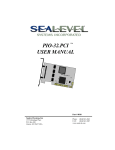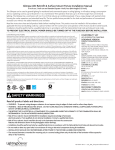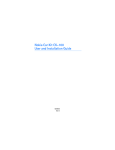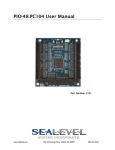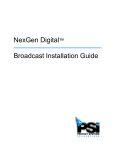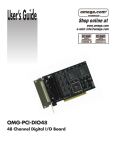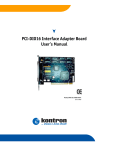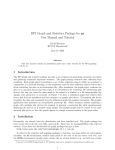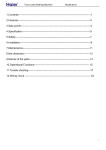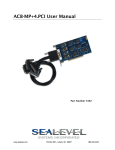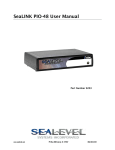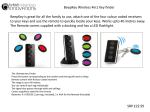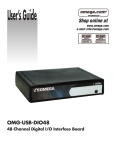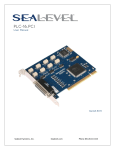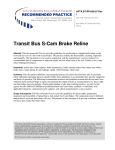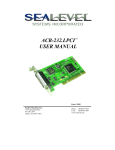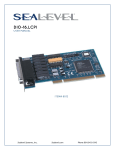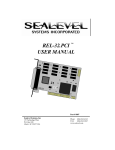Download PIO-24.PCI USER MANUAL
Transcript
PIO-24.PCI USER MANUAL TM Part # 8008 Sealevel Systems, Inc 155 Technology Place P.O. Box 830 Liberty, SC 29657 USA Phone: (864) 843-4343 FAX: (864) 843-3067 www.sealevel.com Contents Introduction.................................................................................................................................1 OVERVIEW ................................................................................................................................................... 1 WHAT’S INCLUDED ...................................................................................................................................... 1 Installation...................................................................................................................................1 CARD SETUP ................................................................................................................................................ 1 SOFTWARE INSTALLATION ........................................................................................................................... 1 Linux Users ............................................................................................................................................................ 1 SYSTEM INSTALLATION ................................................................................................................................ 1 Technical Description .................................................................................................................2 WINDOWS SOFTWARE .................................................................................................................................. 2 LINUX SOFTWARE ........................................................................................................................................ 2 3RD PARTY SOFTWARE SUPPORT ................................................................................................................... 2 50 PIN RIBBON CABLE PIN OUT ..................................................................................................................... 3 ELECTRICAL CHARACTERISTICS ................................................................................................................... 4 PULL UPS ..................................................................................................................................................... 4 Programming ..............................................................................................................................5 APPLICATION PROGRAMMERS INTERFACE (API) ......................................................................................... 5 PRESETTING AN OUTPUT PORT:.................................................................................................................... 5 INTERRUPTS: ................................................................................................................................................ 5 PORT C......................................................................................................................................................... 5 PORT CONFIGURATION:................................................................................................................................ 5 CONTROL WORDS ........................................................................................................................................ 6 RELATIVE ADDRESSING VS. ABSOLUTE ADDRESSING .................................................................................. 6 DIRECT HARDWARE CONTROL ..................................................................................................................... 8 Reading the Inputs:................................................................................................................................................. 8 Reading the Outputs: .............................................................................................................................................. 8 Presetting an Output Port:....................................................................................................................................... 8 Writing the Outputs: ............................................................................................................................................... 8 Bit Set/Reset ........................................................................................................................................................... 8 Port Configuration: ................................................................................................................................................. 8 Interrupts ................................................................................................................................................................ 8 Register Description (for direct hardware control) ................................................................................................. 9 CONTROL WORDS ........................................................................................................................................ 9 I/O Configuration ................................................................................................................................................... 9 Bit Set or Reset Port C.......................................................................................................................................... 10 Interrupt control.................................................................................................................................................... 10 Interrupt mode select table ................................................................................................................................... 10 Interrupt Read....................................................................................................................................................... 11 Specifications .............................................................................................................................12 ENVIRONMENTAL SPECIFICATIONS ............................................................................................................ 12 POWER CONSUMPTION ............................................................................................................................... 12 MEAN TIME BETWEEN FAILURES (MTBF)................................................................................................. 12 PHYSICAL DIMENSIONS .............................................................................................................................. 12 Appendix A - Troubleshooting ................................................................................................13 Appendix B - How To Get Assistance .....................................................................................14 Appendix C - Silk-Screen .........................................................................................................15 Appendix D - Compliance Notices...........................................................................................16 FEDERAL COMMUNICATIONS COMMISSION STATEMENT ............................................................................ 16 EMC DIRECTIVE STATEMENT .................................................................................................................... 16 Warranty .......................................................................................Error! Bookmark not defined. © 2003a Sealevel Systems, Incorporated. All rights reserved. Introduction and Installation Introduction Overview The Sealevel Systems PIO-24.PCI provides one 8255 mode 0 compatible port providing two eight-bit ports and two four-bit ports. When configured as outputs each bit of the two four-bit ports may be set or reset individually. What’s Included The PIO-24.PCI is shipped with the following items. If any of these items is missing or damaged, contact the supplier. • • • PIO-24.PCI Adapter Sealevel Software CD Industry Standard Relay Rack Cables are Available: Part number CA135 for Edge Connection Part number CA167 for IDC Connection Installation Card Setup The PIO-24.PCI is a fully compliant PCI ‘Plug and Play’ adapter. All card resources (i.e. I/O address, IRQ selection) are auto-assigned by either your system BIOS or your ‘Plug and Play’ operating system. Software Installation For proper operation install software first. To install the software place the CD in your CD-ROM tray and the autorun program will start. If auto-run is not available browse the CD and choose “index.htm”. Choose Install Software at the beginning of the CD. Select the Digital I/O software drivers and install SeaIO prior to installing hardware. Linux Users Refer to the installation instructions at the beginning of the CD for details on installing the Sealevel Systems digital I/O cards in Linux. System Installation The PIO-24.PCI can be installed in any of the PCI expansion slots. 1. Turn off PC power. Disconnect the power cord. 2. Remove the PC case cover. 3. Locate an available PCI slot and remove the blank metal slot cover. 4. Remove the clamping portion of the bracket from the card. 5. Gently insert the PIO-24.PCI into the slot. Make sure that the adapter is seated properly. 6. Feed the 50-pin ribbon cable through the cutout bracket and connect it to the card. 7. Replace the bracket retaining screw. 8. Install the clamping portion of the bracket 9. Replace the computer cover. 10. Connect the power cord. Installation is complete. Sealevel Systems PIO-24.PCI Page 1 Technical Description Technical Description The PIO-24.PCI provides 24 channels of digital I/O configurable as inputs or outputs, which can be utilized for PC based control and automation of equipment including: sensors, switches, satellite antenna control systems, video and audio studio automation, security control systems, and other industrial automation systems. Windows Software The PIO-24.PCI ships with Sealevel Systems’ SeaI/O suite of Windows 98/NT/ME/2000 drivers. SeaI/O provides the user with a consistent and straightforward API, allowing the developer to concentrate on the details of the application as opposed to low level driver development. Popular development environments, including Visual C++, Visual Basic, and Delphi, are supported for application development. SeaI/O includes a utility for configuring the driver parameters under Windows, further simplifying installation. Sample applications are included to facilitate rapid application development. Linux Software The PIO-24.PCI ships with software for Linux, including a kernel-mode driver, API, and the SeaIOTst diagnostic tool. The kernel-mode driver is provided as a module, so future driver upgrades may be performed with minimal (usually zero) downtime. The Linux API is identical to its Windows counterpart, facilitating quick and easy ports of existing SeaI/O-aware applications to the Linux operating system. All source code for the Linux software suite is provided under the GNU Public License (GPL v2.0), to assist in "roll-your-own"-type applications. 3rd Party Software Support Third party software support for many HMI/MMI and other process control software is included on the product installation CD. For the most up to date information on third party software support, please visit http://www.sealevel.com/3rdpartysw.htm. Sealevel Systems PIO-24.PCI Page 2 Technical Description 50 pin ribbon cable pin out Description Pin # Port A A0 47 A1 45 A2 43 A3 41 A4 39 A5 37 A6 35 A7 33 Port B B0 31 B1 29 B2 27 B3 25 B4 23 B5 21 B6 19 B7 17 Port C C0 15 C1 13 C2 11 C3 9 C4 7 C5 5 C6 3 C7 1 GND +5V Sealevel Systems PIO-24.PCI All Even pins 49 Page 3 Technical Description Electrical Characteristics The table below provides the electrical characteristics of each Input/Output. Each port is buffered with a 74LS245 octal bi-directional transceiver. Each input is capable of sinking up to 24 mA, while each output can source up to 15 mA. Recommended Operating Conditions Min Max Input 0V 5.25 V Source 15 mA Sink 24 mA Electrical Characteristics High Level Input Voltage Min 2 V Low Level Input Voltage Max 0.8 V High Level Output Voltage Low Level Output Voltage Min 2 V at 15 mA Typically 3.4 V at 3 mA Max 0.55 V at 24 mA Pull Ups Nine or ten pin bussed resistor packs are installed to provide pull-ups to the input ports. These are installed on all ports. The pull-up resistor packs are rated at 10K ohms. The table below provides the bussed resistor and corresponding port. The resistors insure that no line is floating which is not connected. This provides consistent biasing on all un-terminated lines. Bussed Resistor RP1 RP2 RP3 Sealevel Systems PIO-24.PCI Corresponding Port Port A Port B Port C Page 4 Technical Description Programming Application Programmers Interface (API) Most modern operating systems do not allow direct hardware access. The SeaIO driver and API have been included to provide control over the hardware in Windows and Linux environments. The purpose of this section of the manual is to help the customer with the mapping of the API to the actual inputs for the PIO-24.PCI specifically. Complete documentation of the API can be found in its accompanying help file. Presetting an Output Port: Each port has an output register associated with it. This register may be written and retains its value whether the port is configured as an input or an output. To preset the value of an output port the program should write to the port when it is configured as an input then configure it as an output. Inputs cannot be written to with relative addressing, absolute addressing must be used. See Relative Addressing vs. Absolute Addressing below. Interrupts: Interrupt sampling can be set up in the API. Port A bit zero is the interrupt source(pin 47). Refer to the API section in the SeaI/O help file for more detailed information. Port C Port C has the ability to be configured as two four bit ports. If both lower and upper nibbles are configured the same then no special considerations need to be made. But if they are configured differently, one nibble as input, and one as output then the user will have to keep this in mind. Port C absolute addressing (when port C is split) When reading, the input nibble will be returned on the corresponding upper or lower nibble while the outputs will be returned on their corresponding upper or lower nibble. When writing, the corresponding nibble will be written to the output nibble, while the input nibble will have its output register written to. The output register can be written to without affecting the inputs. These will be eight bit operations and it will up to the programmer to keep track of the two four bit nibbles. Port C relative addressing (when port C is split) The input and output nibbles will each be treated as individual four bit ports. Port Configuration: Each eight-bit port can be configured as inputs or outputs. The API provides a set adapter state call to access the control words. For this device, one control word is used. Note: The control panel also allows you to configure the device. Your program can over ride the control panel configuration when executed, but the control panel configuration will be the default on power up. The default settings are based on the settings in the control panel application when last changed and saved after re-booting. Sealevel Systems PIO-24.PCI Page 5 Technical Description Control Words I/O Configuration CWnD0 CWnD1 CWnD2 CWnD3 CWnD4 CWnD5 CWnD6 CWnD7 Port C1 lower nibble (bits 0-3) Port B1 1 = input 0 = output 1 = input 0 = output 0 or 1 (no effect) Port C1 upper nibble (bits 4-7) 1 = input 0 = output Port A1 1 = input 0 = output 0 or 1 (no effect) 0 or 1 (no effect) Always a 1 1 on power up 1 on power up 1 on power up 1 on power up Relative Addressing vs. Absolute Addressing The SeaIO API makes a distinction between “absolute” and “relative” addressing modes. In absolute addressing mode, the Port argument to the API function acts as a simple byte offset from the base I/O address of the device. For instance, Port #0 refers to the I/O address base + 0; Port #1 refers to the I/O address base + 1. Relative addressing mode, on the other hand, refers to input and output ports in a logical fashion. With a Port argument of 0 and an API function meant to output data, the first (0th) output port on the device will be utilized. Likewise, with a Port argument of 0 and an API function designed to input data, the first (0th) input port of the device will be utilized. In all addressing modes, port numbers are zero-indexed; that is, the first port is port #0, the second port is #1, the third #2, and so on. The following tables give the: API Port/bit reference numbers for Absolute and Relative Addressing R = Read W = Write R/W = Read or Write Port API Port # Absolute Address (function) A 0 ( R/W ) B 1 ( R/W ) C 2 ( R/W ) Absolute byte Address, (any configuration) Port A B C API Port # Relative Address (function) 0(R) 0(W) 1(W) Relative Byte Address Port Type Input Port Output Port Output Port Port A B C Lower C Upper API Port # Relative Address (function) 0(R) 0(W) 1(W) 1(R) Port Type Input Port Output Port Output Port Input Port Sealevel Systems PIO-24.PCI Page 6 Technical Description API Bit # Absolute Address (function) API Bit # Relative Address (function) Port Bit 0 ( R/w ) 1 ( R/w ) 2 ( R/w ) 3 ( R/w ) 4 ( R/w ) 5 ( R/w ) 6 ( R/w ) 7 ( R/w ) 8 ( R/w ) 9 ( R/w ) 10 ( R/w ) 11 ( R/w ) 12 ( R/w ) 13 ( R/w ) 14 ( R/w ) 15 ( R/w ) 16 ( R/W ) 17 ( R/W ) 18 ( R/W ) 19 ( R/W ) 20 ( R/W ) 21 ( R/W ) 22 ( R/W ) 23 ( R/W ) 0(R) 1(R) 2(R) 3(R) 4(R) 5(R) 6(R) 7(R) 0(W) 1(W) 2(W) 3(W) 4(W) 5(W) 6(W) 7(W) 8(W) 9(W) 10( W ) 11( W ) 8( R ) 9( R ) 10( R ) 11( R) A0 - Input A1 - Input A2 - Input A3 - Input A4 - Input A5 - Input A6 - Input A7 - Input B0 - Output B1 - Output B2 - Output B3 - Output B4 - Output B5 - Output B6 - Output B7 - Output C0 - Output C1 - Output C2 - Output C3 - Output C4 - Input C5 - Input C6 - Input C7 - Input Relative Byte Address Sealevel Systems PIO-24.PCI Page 7 Technical Description Direct Hardware Control In systems where the users program has direct access to the hardware (DOS) the tables below gives the mapping and functions that the PIO-24.PCI provide. The address of each eight-bit port is calculated as shown in the table on the following page, the cards base address plus an offset. Reading the Inputs: The inputs are active high. If an input is driven high (2V to 5.25 V) it will read as a logical one (1), if driven low (0V to 0.8V) it will read as a logical zero (0). If an input is not driven it will read as a one due to the 10K ohm pull up resistors on each port. Reading the Outputs: The value that is currently being used to drive the outputs will be returned. Presetting an Output Port: Each port has an output register associated with it. This register may be written and retains its value whether the port is configured as an input or an output. To preset the value of an output port the program should write to the port when it is configured as an input then configure it as an output. Writing the Outputs: The outputs are active high. Writing a one (1) corresponds to 5V while writing a zero (0) corresponds to 0V, at the output. Bit Set/Reset Port C supports bit set/reset as shown in the tables below. Port Configuration: Each port can be configured as an input or an output by writing to its direction control bit, refer to the tables below. Interrupts Interrupts can be set up as shown in the tables below. Port A1 bit zero is the interrupt source, (pin 47) . Sealevel Systems PIO-24.PCI Page 8 Technical Description Port C Port C is written and read to as a single eight bit port, but it has the ability to be configured as two four bit ports. If both lower and upper nibbles are configure the same then no special considerations need to be made. But if they are configured differently, one nibble as input, and one as output then the user will have to keep this in mind. When reading, the input will be returned on the corresponding upper or lower nibble while the current outputs will be returned on their corresponding upper or lower nibble. When writing, the corresponding nibble will be written to the output nibble, while the input nibble will have its output register written to. The output register can be written to without affecting the inputs. Register Description (for direct hardware control) Address Port ID Base+0 Port A R/W Base+1 Port B R/W Base+2 Port C R/W Base+3 Control Word Port Base+4 Int. Config. Port Base+5 Int. Status Port Mode D7 D6 D5 D4 D3 D1 D0 PAD7 PAD6 PAD5 PAD4 PAD3 PAD2 PAD1 PAD0 PBD7 PBD6 PBD5 PBD4 PBD3 PBD2 PBD1 PBD0 PCD7 PCD6 PCD5 PCD4 PCD3 PCD2 PCD1 PCD0 0 CWD1 CWD0 W CWD7 0 0 R/W 0 0 0 0 0 R 0 0 0 0 0 D2 CWD4 CWD3 IRQEN IRQC11 IRQC10 0 0 IRQST Control Words I/O Configuration CWnD0 CWnD1 CWnD2 CWnD3 CWnD4 CWnD5 CWnD6 CWnD7 7 1 1 1 1 1 1 1 1 1 1 1 1 1 1 1 1 6 X X X X X X X X X X X X X X X X Port C1 lower nibble (bits 0-3) Port B1 1 = input 0 = output 1 = input 0 = output 0 or 1 (no effect) Port C1 upper nibble (bits 4-7) 1 = input 0 = output Port A1 1 = input 0 = output 0 or 1 (no effect) 0 or 1 (no effect) Always a 1 Control Word (X = 0) 5 4 3 2 X 0 0 X X 0 0 X X 0 0 X X 0 0 X X 0 1 X X 0 1 X X 0 1 X X 0 1 X X 1 0 X X 1 0 X X 1 0 X X 1 0 X X 1 1 X X 1 1 X X 1 1 X X 1 1 X Sealevel Systems PIO-24.PCI Hex Value 1 0 0 1 1 0 0 1 1 0 0 1 1 0 0 1 1 0 0 1 0 1 0 1 0 1 0 1 0 1 0 1 0 1 80 81 82 83 88 89 8A 8B 90 91 92 93 98 99 9A 9B A Out Out Out Out Out Out Out Out In In In In In In In In B Out Out In In Out Out In In Out Out In In Out Out In In 1 on power up 1 on power up 1 on power up 1 on power up Port Setup C Upper Out Out Out Out In In In In Out Out Out Out In In In In C Lower Out In Out In Out In Out In Out In Out In Out In Out In Page 9 Technical Description Bit Set or Reset Port C CWD0 CWD4 CWD5 CWD6 CWD7 1 = set to +5V 0 = Reset to GND 0 or 1 (no effect) 0 or 1 (no effect) 0 or 1 (no effect) Always a zero when using Bit set/reset CWnD3 0 0 0 0 1 1 1 1 7 6 0 0 0 0 0 0 0 0 X X X X X X X X 0 0 0 0 0 0 0 0 X X X X X X X X Bit Select CWnD2 CWnD1 0 0 0 1 1 0 1 1 0 0 0 1 1 0 1 1 Control Word (X = 0) 5 4 3 2 1 Reset X X 0 0 0 X X 0 0 1 X X 0 1 0 X X 0 1 1 X X 1 0 0 X X 1 0 1 X X 1 1 0 X X 1 1 1 Set X X 0 0 0 X X 0 0 1 X X 0 1 0 X X 0 1 1 X X 1 0 0 X X 1 0 1 X X 1 1 0 X X 1 1 1 C1 Bit =0 =1 =2 =3 =4 =5 =6 =7 Hex Value Port C Bit 0 0 0 0 0 0 0 0 00 02 04 06 08 0A 0C 0E 0 1 2 3 4 5 6 7 1 1 1 1 1 1 1 1 01 03 05 07 09 0B 0D 0F 0 1 2 3 4 5 6 7 0 Interrupt control IRQENX IRQCX0 IRQCX1 interrupt enable 1 = enabled 0 = disabled ( 0 on power up ) Interrupt mode select see table Interrupt mode select see table Interrupt mode select table IRQCX1 0 0 1 1 Sealevel Systems PIO-24.PCI IRQCX0 0 1 0 1 INT Type Low level High level Falling edge Rising edge Page 10 Technical Description Interrupt Read IRQST1 (D0) Interrupt status 1 = interrupt pending, 0 = none Reading this port clears a pending interrupt Sealevel Systems PIO-24.PCI Page 11 Specifications Specifications Environmental Specifications Specification Temperature Range Humidity Range Operating 0º to 50º C (32º to 122º F) 10 to 90% R.H. Non-Condensing Storage -20º to 70º C (-4º to 158º F) 10 to 90% R.H. Non-Condensing Power Consumption +5 VDC 480mA Supply line Rating Mean Time Between Failures (MTBF) Greater than 150,000 hours. (Calculated) Physical Dimensions Board Length Board Height including Goldfingers Board Height excluding Goldfingers Sealevel Systems PIO-24.PCI 4.72 inches 3.70 inches 3.375 inches (11.988 cm.) (9.398cm.) (8.572 cm.) Page 12 Appendix A - Troubleshooting Appendix A - Troubleshooting Following these simple steps can eliminate most common problems. Install software first. After installing the software then proceed to adding the hardware. This places the required installation files in the correct locations. 1. Read this manual thoroughly before attempting to install the adapter in your system. 2. Use Device Manager under Windows to verify proper installation. 3. Use the SeaIO control panel applet for card identification and configuration. 4. If these steps do not solve your problem, please call Sealevel Systems’ Technical Support, (864) 843-4343. Our technical support is free and available from 8:00AM-5PM Eastern Time Monday through Friday. Sealevel Systems PIO-24.PCI Page 13 Appendix B - How To Get Assistance Appendix B - How To Get Assistance Please refer to Troubleshooting Guide prior to calling Technical Support. 1. Begin by reading through the Trouble Shooting Guide in Appendix A. If assistance is still needed please see below. 2. When calling for technical assistance, please have your user manual and current adapter settings. If possible, please have the adapter installed in a computer ready to run diagnostics. 3. Sealevel Systems provides an FAQ section on its web site. Please refer to this to answer many common questions. This section can be found at http://www.sealevel.com/faq.htm . 4. Sealevel Systems maintains a Home page on the Internet. Our home page address is www.sealevel.com. The latest software updates, and newest manuals are available via our FTP site that can be accessed from our home page. 5. Technical support is available Monday to Friday from 8:00 a.m. to 5:00 p.m. eastern time. Technical support can be reached at (864) 843-4343. RETURN AUTHORIZATION MUST BE OBTAINED FROM SEALEVEL SYSTEMS BEFORE RETURNED MERCHANDISE WILL BE ACCEPTED. AUTHORIZATION CAN BE OBTAINED BY CALLING SEALEVEL SYSTEMS AND REQUESTING A RETURN MERCHANDISE AUTHORIZATION (RMA) NUMBER. Sealevel Systems PIO-24.PCI Page 14 Appendix C - Silk-Screen Appendix C - Silk-Screen 3.70" 4.20" Sealevel Systems PIO-24.PCI Page 15 Appendix D - Compliance Notices Appendix D - Compliance Notices Federal Communications Commission Statement FCC - This equipment has been tested and found to comply with the limits for Class A digital device, pursuant to Part 15 of the FCC Rules. These limits are designed to provide reasonable protection against harmful interference when the equipment is operated in a commercial environment. This equipment generates, uses, and can radiate radio frequency energy and, if not installed and used in accordance with the instruction manual, may cause harmful interference to radio communications. Operation of this equipment in a residential area is likely to cause harmful interference. In such case the user will be required to correct the interference at his own expense. EMC Directive Statement Products bearing the CE Label fulfill the requirements of the EMC directive (89/336/EEC) and of the low-voltage directive (73/23/EEC) issued by the European Commission. To obey these directives, the following European standards must be met: • EN55022 Class A - “Limits and methods of measurement of radio interference characteristics of information technology equipment” • EN55024 -'Information technology equipment Immunity characteristics Limits and methods of measurement' • EN60950 (IEC950) - “Safety of information technology equipment” equipment, including electrical business Warning This is a Class A Product. In a domestic environment this product may cause radio interference in which case the user may be required to take adequate measures. Always use cabling provided with this product if possible. If no cable is provided or if an alternate cable is required, use high quality shielded cabling to maintain compliance with FCC/EMC directives. Sealevel Systems PIO-24.PCI Page 16 Warranty Warranty Sealevel Systems, Inc. provides a limited lifetime warranty. Should this product fail to be in good working order at any time during this period, Sealevel Systems will, at it’s option, replace or repair it at no additional charge except as set forth in the following terms. This warranty does not apply to products damaged by misuse, modifications, accident or disaster. Sealevel Systems assumes no liability for any damages, lost profits, lost savings or any other incidental or consequential damage resulting from the use, misuse of, or inability to use this product. Sealevel Systems will not be liable for any claim made by any other related party. RETURN AUTHORIZATION MUST BE OBTAINED FROM SEALEVEL SYSTEMS BEFORE RETURNED MERCHANDISE WILL BE ACCEPTED. AUTHORIZATION CAN BE OBTAINED BY CALLING SEALEVEL SYSTEMS AND REQUESTING A RETURN MERCHANDISE AUTHORIZATION (RMA) NUMBER. Sealevel Systems, Incorporated 155 Technology Place P.O. Box 830 Liberty, SC 29657 USA (864) 843-4343 FAX:(864) 843-3067 www.sealevel.com email: [email protected] Technical Support is available from 8 a.m. to 5 p.m. Eastern time. Monday - Friday Trademarks Sealevel Systems, Incorporated acknowledges that all trademarks referenced in this manual are the service mark, trademark, or registered trademark of the respective company. PIO-24.PCI is a trademark of Sealevel Systems, Incorporated. Sealevel Systems PIO-24.PCI Page 17




















